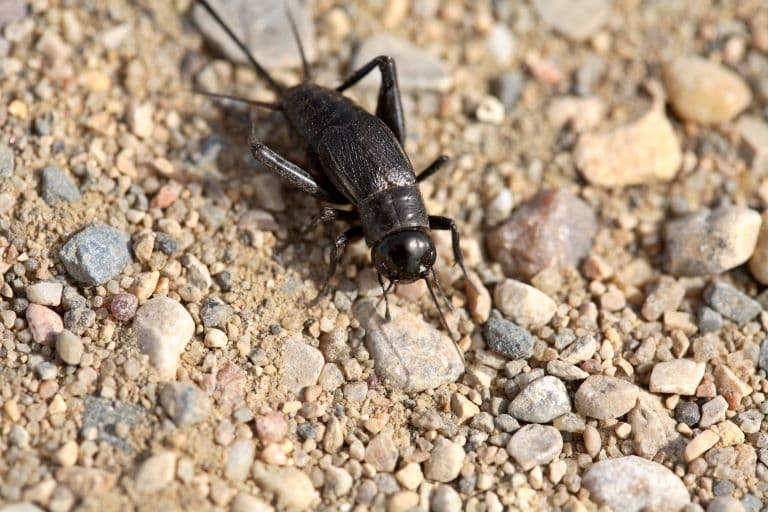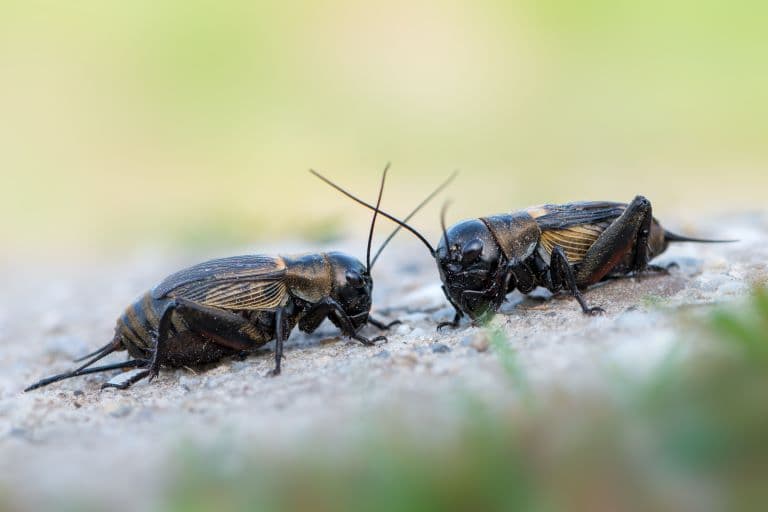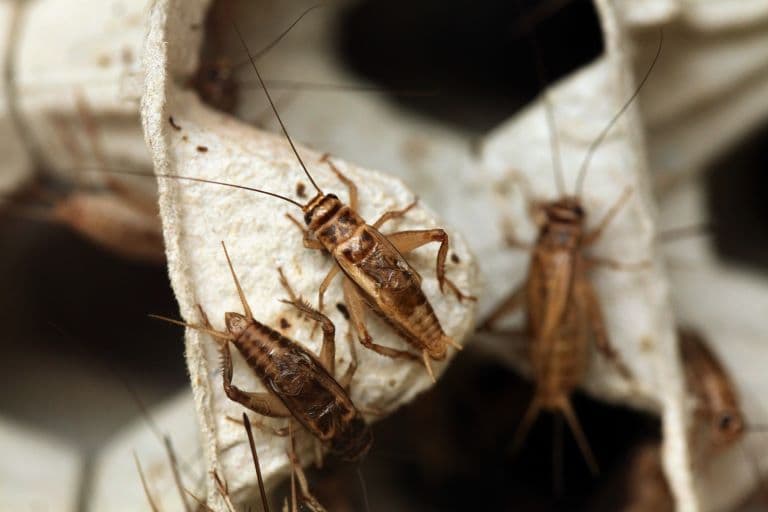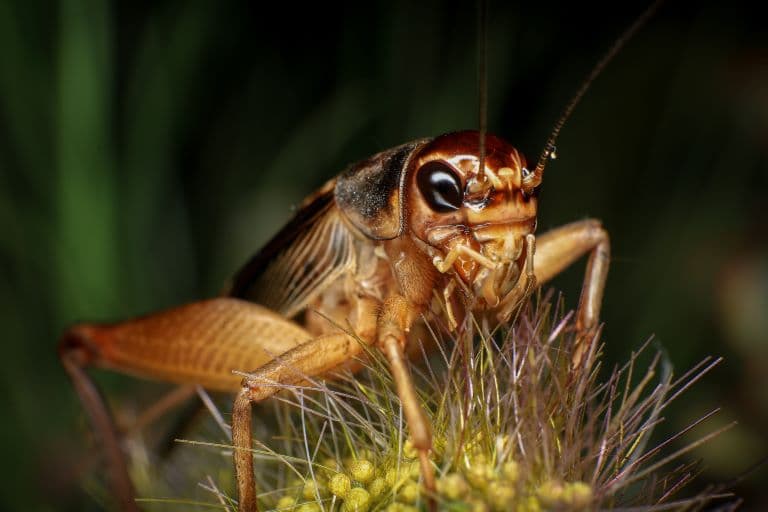Cricket Profile
Lots of things get the name cricket: mole crickets, scaly crickets, cricket bats, but there’s only one group of insects that have been historically considered true crickets, and these are the Gryllidae family of orthopteran insects.
But recently, the term has expanded by a taxonomic step, and while mole crickets and cricket bats are still outside of this definition, new families are now being welcomed under the term.

Cricket Facts Overview
| Habitat: | Grassland, bushes, and forests to marshes, beaches, and caves |
| Location: | Worldwide except the far Northern latitudes |
| Lifespan: | Six weeks to a year |
| Size: | From 5mm (0.2 inches) to 5 cm (2 inch) |
| Weight: | Usually Under 1g |
| Colour: | Usually brown to black |
| Diet: | Most are generalist omnivores, some predatory |
| Predators: | Most insectivores |
| Top Speed: | Slow, |
| No. of Species: | 3700 |
| Conservation Status: | Most are of Least Concern (IUCN) |
Crickets are a confusing lot of Orthopteran insects that few can agree on. The waters are heavily clouded by the colloquial terms using the same name, but even in scientific research, it’s hard to pinpoint exactly where the cricket name ends.
There are recent developments, primarily based on how many foot joints they’ve got, but for this piece, we’re only going to stick to that loosely, so we can cover the most interesting cricket-esque facts.
Interesting Cricket Facts
1. What even is a cricket?
Colloquially, most animals in the orthopteran order get referred to as crickets by somebody, but it is also a strict taxonomic term, and figuring out what that means has been a source of contention. Until recently, true crickets were the only true crickets, but the expansion of the definition by contemporary taxonomists has welcomed some of the other families too.
Now, the definition of a ‘cricket’ is anything within the superfamily Grylloidea, which is distinct from the rest of the suborder Ensifera, which contains all the cricket-looking orthopterans like Wetas and katydids.
Crickets are distinct from these others by several anatomical features that are really only visible on very close inspection, so misnaming them is really only a cardinal sin if you have a microscope.
In short, crickets now include true crickets, scaly crickets, wood crickets and sword-tailed crickets, among a few others.
Mole, Jerusalem and ant crickets have been rejected on account of them having too many tarsal segments and will have to find their own name. So have the infamous wart-biter crickets, members of the Tettigonioidea superfamily, who are unfortunately not qualified for the title.

2. They’re food
Crickets occupy that unfortunate position on the ecological ladder that might as well be known as ‘fodder’. They’re meaty, soft, abundant and entirely defenceless, and have evolved as much as a source of food for everything else as for the success of their own.
To reduce some of the carnage, they’ve evolved to be nocturnal, leaving the day shift up to the grasshoppers, who fill a similar niche during those hours.
But even so, they have an enormous range of predators. Ants, frogs, bats, beetles, spiders, foxes, cats, and humans, to name a handful, are all common consumers of these little animals.
So, there are lots of them. Crickets exert a pressure on their environment from the sheer number that exist, converting mostly plant matter into soluble nutrition for the lower trophic levels, but also providing a substantial amount of the biomass that ends up in larger animals.
In a more captive setting, the ease with which they breed and their lack of dangerous by-products make them primary food animals in zoos and exotic pet collections.
Cricket flour, a tremendously more efficient, sustainable and healthier alternative animal protein, is being pushed into the market in the West, as a replacement for vertebrate protein. In the East, crickets are among many of the insects traditionally eaten already.
Crickets thrive in high densities, grow fast, and have more protein per gram than beef, with a fraction of the production costs. 1

3. They’re not all defenceless
When we say crickets are defenceless, there are some exceptions. Raspy crickets from Australia are said to have the strongest bite of any insect tested.
Wasps, who bite into wood to make their nests, have a bite that is 1/1200 of the strength of these crickets, and while these are non-jumping crickets from one of the more dubious cricket suborders, they do represent the potential nip that comes out of many in the Ensifera order, and just about the only defence they’ve got. 2
4. Cricket silk
Raspy crickets are only loosely crickets, but because they were once considered in the same group as some of the now-rejected suborders (they’ve since they’ve been removed), we’re going to include them. Not only can they bite, but they can also spin silk!
This family of non-jumping crickets are also wingless and builds shelters in the daytime out of folded leaves, held together with silk.
Some burrow in sand and use the silk to line their holes, and this adaptation is thought to have evolved totally independently of other insects. 3

5. They’re noisy
Anyone who’s lived in cricket territory, or who’s kept spiders, scorpions, or other cricket-eaters – or indeed the crickets themselves – should be familiar with the soothing chirps crickets can make, and these sounds are part of an impressive communication system that makes use of two specialised organs.
The first is the tool of stridulation, or file, which is scraped by a stiff part of the cricket’s wing. One wing has a file and the other has a scraper, and it’s in the rubbing of these two tools together that you get the dulcet tones of the nocturnal cricket chorus.
They make these sounds for other crickets, which means they also have the corresponding organ for receiving them.
6. They have ears on their legs
In insects, ears are called tympanal organs. These are essentially an ear drum, stretched across an air sac and work similarly to a human ear, in that they vibrate and channel vibrations to the sensory neurons associated with them.
This organ is situated on the front leg of crickets, so they hear with their knees! 4
7. They’re social
Crickets don’t just sing to one another, they also have a pecking order, which they establish by wrestling and whipping one another with their antennae.
If the initial flashes of aggression aren’t persuasive, grappling ensues, and the pair will utter unique sounds that are only associated with fighting.
The winner will release a victory call, again, unique to the context, and the loser will silently retreat. 5

8. They’re cute
Aside from being food, these are also very adorable animals. Their soft song, harmless nature and the fact that they can safely share a space with humans without becoming a pest make them good pets.
In some cultures in China and Japan, they’re traditionally considered good luck and are kept in gourds.

Cricket Fact-File Summary
Scientific Classification
| Kingdom: | Animalia |
| Phylum: | Arthropoda |
| Class: | Insecta |
| Order: | Orthoptera |
| Family: | 4 or more |
| Superfamily: | Gryllioidea |
Fact Sources & References
- Business Insider (2022), “How North America’s Largest Cricket Farm Harvests 50 Million A Week”, YouTube.
- Carissa Wong (2022), “Australian raspy cricket has the strongest bite of 650 insect species”, New Scientist.
- Andrew A Walke(2012), “Silk from crickets: a new twist on spinning”, NIH.
- Jayne E. Yack (2004), “The structure and function of auditory chordotonal organs in insects”, Wiley Analytical Science.
- Robert W. Matthew (2009), “Insect Behavior”, Google Books.
